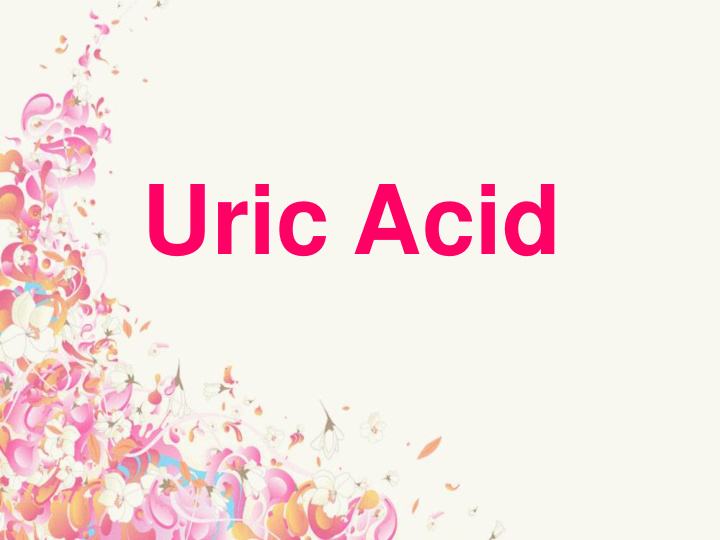



Uric Acid
تابلاطلا دادعا : ئاث انيد رسنوي ليليولنلنا ناندع ايناد لاضن للبلبد يهيهسح
Uric acid Uric acid is a chemical compound created when the body breaks down substances called purines. Purines are found in some foods and drinks, such as liver, dried beans and peas, beer, and wine. Purines are also a part of normal body substances, such as DNA.
In humans, approximately 75% of uric acid excreted is lost in the urine; most of the reminder is secreted into the GIT If your body produces too much uric acid or doesn't remove enough of it, you can get sick. High levels of uric acid in the body is called hyperuricemia Normal values fall between 3.0 and 7.0 mg/dL. Note: Normal values may vary slightly from laboratory to laboratory.
When is it ordered? when a doctor suspects high levels of uric acid : Gout monitoring test when a patient has undergone chemotherapy or radiation if a patient appears to have failing kidneys
Greater-than-normal levels of uric acid (hyperuricemia) may be due to: Alcoholism Diabetes Gout Hypoparathyroidism Lead poisoning Leukemia Nephrolithiasis Polycythemia vera Renal failure Toxemia of pregnancy Purine-rich diet Excessive exercise Chemotherapy-related side effects
Lower-than-normal levels of uric acid may be due to: Fanconi syndrome Wilson's disease Syndrome of inappropriate antidiuretic hormone (SIADH) secretion Multiple Sclerosis Low purine die
Gout Gout is a kind of arthritis that occurs when uric acid builds up in the joints. In Gout increased serum levels of uric acid lead to formation of monosodium urate crystals around the joints. Acute gout is a painful condition that typically affects one joint. Chronic gout is repeated episodes of pain and inflammation, which may involve more than one joint. The exact cause is unknown. Gout may run in families. It is more common in males, postmenopausal women, and people who drink alcohol
Symptoms of acute gouty attacks : Symptoms develop suddenly and usually involve only one or a few joints. The big toe, knee, or ankle joints are most often affected . The pain frequently starts during the night and is often described as throbbing, crushing, or excruciating . The joint appears warm and red. It is usually very tender. There may be a fever . The attack may go away in several days, but may return from time to time. Additional attacks usually last longer .
After a first gouty attack, people will have no symptoms. Some people will go months or even years between gouty attacks . Some people may develop chronic gouty arthritis, but others may have no further attacks. Those with chronic arthritis develop joint deformities and loss of motion in the joints. They will have joint pain and other symptoms most of the time . Tophi are lumps below the skin around joints or in other places. They may drain chalky material. Tophi usually develop only after a patient has had the disease for many years . After one gouty attack, more than half of people will have another attack .
A tophus on the elbow of a middle aged man with chronic gout .
Tests that may be done include : Synovial fluid analysis Gold standard to confirm gout, Urate crystals identified by: - Needle and rod shapes Uric acid - blood Joint x-rays ) may be normal)
X-ray of gouty uric acid deposit in the big toe (left )
Possible Complications Chronic gouty arthritis Kidney stones Deposits in the kidneys, leading to chronic kidney failure
Treatment Treatments for a sudden attack or flare-up of gout : Your doctor will recommend that you take nonsteroidal anti-inflammatory drugs (NSAIDs) such as ibuprofen, naproxen, or indomethacin as soon as your symptoms begin Your health care provider may occasionally prescribe strong painkillers such as codeine Daily use of allopurinol decrease uric acid levels in your blood
Some diet and lifestyle changes may help prevent gouty attacks : Avoid alcohol, sardines, oils, organ meat (liver, kidney, and sweetbreads ( Limit how much meat you eat at each meal. Avoid fatty foods such as salad dressings, ice cream, and fried foods Eat enough carbohydrates If you are losing weight, lose it slowly. Quick weight loss may cause uric acid kidney stones to form.
Specimen Serum or plasma may be used; slight but insignificant positive bias (0.2 mg/dL) has been noted in plasma specimens as compared with serum. Stability in serum / plasma: 6 months at -20 ° C 7 days at 4-8 ° C 3 days at 20-25 ° C
Enzymatic Colorimetric Uricase 1-Uric acid + H 2 O + O 2 Allantion + CO 2 + H 2 O 2 POD 2-TBHBA + 4- Aminoantipyrine + 2H 2 O 2 Quinoneimine + 3 H 2 O -Uric acid is oxidized to allantoin by uricase. -The generated hydrogen peroxide reacts with 4- aminophenazone/ESPT to quinoneimine.
Note: Uric acid may also form kidney stones Although uric acid can act as an antioxidant, excess serum accumulation is often associated with cardiovascular disease.
Recommend
More recommend